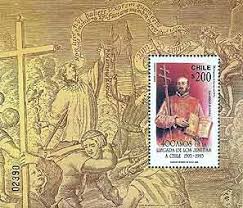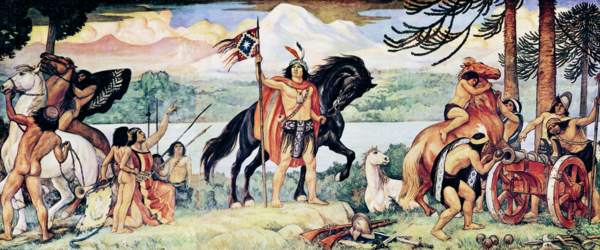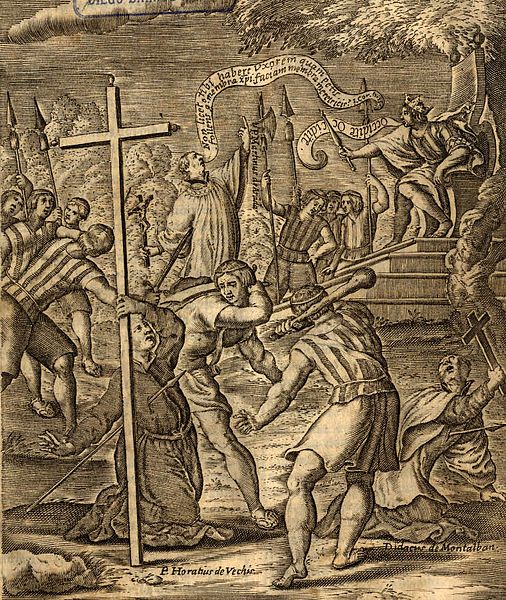Servants of God - Horace Vecchi, Martin de Aranda, James de Montalban,SJ
Died: December 14, 1612
 Today we honour three Jesuits, Frs Horace Vecchi and Martin de Aranda and Bro James de Montalban who were martyred by the Araucanian Indians in Elicura, Chile, in 1612.
Today we honour three Jesuits, Frs Horace Vecchi and Martin de Aranda and Bro James de Montalban who were martyred by the Araucanian Indians in Elicura, Chile, in 1612.
Fr Horace Vecchi was born in Siena, Italy and at the age of sixteen began law studies at the University of Siena. He abandoned that in 1597 to enter the Society in Rome on September 9, 1597 before he turned twenty. After his noviceship, he studied at the Roman College and it was there that the idea of serving in Peru was planted as he was inspired after hearing a Jesuit Peruvian missionary talking about the work of his brother Jesuits among the native people. His request to serve in Peru was granted and on 1 April 1604 he left Spain and arrived in Lima, Peru in early 1605. He completed his studies and was ordained in 1608. He then went to the Arauco district in central Chile to work with the tribes that were at peace with the Spaniards. Fr Vecchi’s missionary apostolate only lasted for four years; his death on December 14, 1612 was not brought about by the tribes he worked with but by other uncivilized tribes.
Fr Martin de Aranda was born in Villarrica in Araucanian territory in Chile of Spanish parents. He had been a cavalry officer in the service of the king of Spain. Having successfully headed an expedition to Peru and founded the city of Riobamba, he was appointed its first governor by the Viceroy of Peru. While on recall to Lima to receive an award, he decided while making the Spiritual Exercises, that the only service worthy of him was the service to God. Thus on March 12, 1592, he entered the Society initially as a brother as he had very little knowledge of Latin. He was persuaded by his superiors after they evaluated his abilities, to study theology in preparation for the priesthood. He was ordained in 1596 and was assigned to assist Fr Michael de Urrea in his work among the Chuncho Indians in the Peruvian Andes. Before he could get to his destination, he received news that Fr Urrea had been killed. He was then reassigned to his native Arauco district as chaplain to the Spanish garrison stationed there. There he cared for the soldiers’ spiritual needs and those of the Indians who lived nearby. As the soldiers had been without a priest for several years, Fr Aranda had much to do and within a short time he had them attending Mass and receiving monthly communion. He did this work for about six years before he and Fr Vecchi were assigned to evangelise the more difficult Araucanian tribes in the Elicura valley.
 In November 1612 the governor and Fr Louis de Valdivia succeeded in negotiating a peace treaty with the still non-civilised Araucanians, including some hard-core chiefs who were known to be reluctant to give up the use of arms. Because the terms of the treaty were reasonable, these chiefs accepted the treaty and soon others did likewise. With this the Araucanian caciques requested missionaries to live among them. One of the caciques, Anganamon’s three wives, one a Spanish captive and the other two Indians, together with their daughters, had recently escaped from him and had sought refuge with the Spaniards. He wanted to take revenge against them but the Spaniards said that they could not return as they were now Christians. Although some Spaniards did suggest that Fr Aranda’s mission be postponed because Anganamon could cause trouble and therefore it was unwise to send missionaries to their deaths, the Jesuit provincial nevertheless sent Frs Vecchi and Aranda and Bro James de Montalban to Elicura.
In November 1612 the governor and Fr Louis de Valdivia succeeded in negotiating a peace treaty with the still non-civilised Araucanians, including some hard-core chiefs who were known to be reluctant to give up the use of arms. Because the terms of the treaty were reasonable, these chiefs accepted the treaty and soon others did likewise. With this the Araucanian caciques requested missionaries to live among them. One of the caciques, Anganamon’s three wives, one a Spanish captive and the other two Indians, together with their daughters, had recently escaped from him and had sought refuge with the Spaniards. He wanted to take revenge against them but the Spaniards said that they could not return as they were now Christians. Although some Spaniards did suggest that Fr Aranda’s mission be postponed because Anganamon could cause trouble and therefore it was unwise to send missionaries to their deaths, the Jesuit provincial nevertheless sent Frs Vecchi and Aranda and Bro James de Montalban to Elicura.
 Bro James de Montalban was born in Mexico and had been a tailor and also served in the Spanish army at Lima and Chile. He entered the Society in October 1612 and was a novice for two months before he was sent on his first missionary endeavour.
Bro James de Montalban was born in Mexico and had been a tailor and also served in the Spanish army at Lima and Chile. He entered the Society in October 1612 and was a novice for two months before he was sent on his first missionary endeavour.
On December 14, 1612, five days after the three missionaries had arrived at their mission in Elicura, they were surprised by the sudden appearance of Anganamon and about one hundred of his young braves and demanded his wives and daughters. When the missionaries told him that his wives and children were now Christians and wished to remain among the Spaniards, Anganamon gave orders for his braves to seize them. Fr Vecchi suffered a lance wound in the throat and two axe strokes over his right ear and two in his torso. Fr Aranda’s head was smashed and his body beaten with clubs. Bro Montalban had his head crushed and received six lance wounds in his body and an axe wound in his throat. The Indians then stripped the dead missionaries so that the birds of prey and wild animals could feast on their bodies. The Spaniards recovered the bodies of the three Jesuits soon afterwards and took them to their garrison where Fr Louis de Valdivia celebrated their requiem. Their cause is now under investigation.
